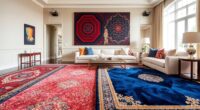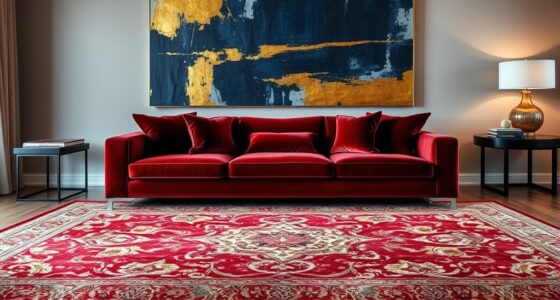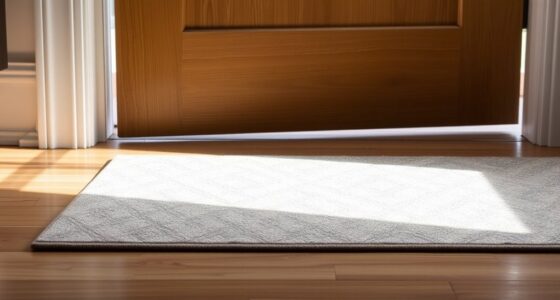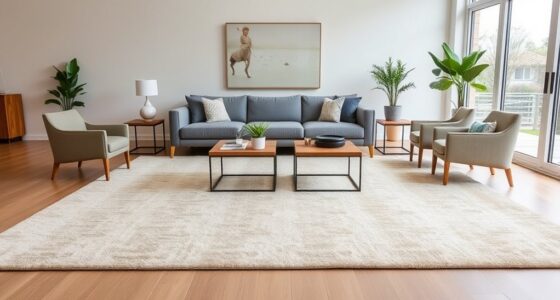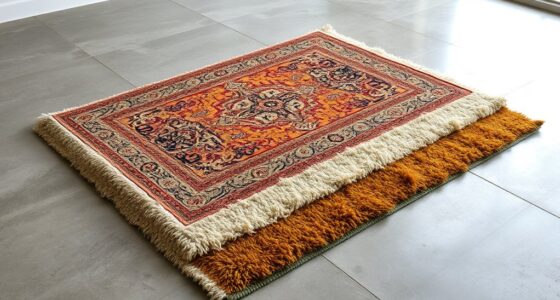To match rug patterns with contemporary furniture, focus on the overall style and mood of your space. For sleek, modern pieces, opt for geometric or clean-lined patterns in neutral or bold hues, balancing for visual harmony. If your furniture is soft and rounded, choose flowing, organic patterns. Keep patterns simple if your furniture is minimalist to avoid clutter. Incorporating textures and cohesive color schemes will tie your space together; explore more tips ahead to perfect your look.
Key Takeaways
- Opt for geometric or abstract patterns that echo the clean lines and sleek silhouettes of contemporary furniture.
- Choose rugs with minimal or bold designs in neutral colors to complement modern, streamlined furniture.
- Balance large, bold patterns with simple, understated furniture to prevent visual clutter.
- Incorporate textured rugs like plush or woven styles to add tactile interest without overpowering minimalist lines.
- Coordinate rug colors with furniture hues and accents to create a cohesive, unified modern aesthetic.
Understanding the Style and Mood of Your Space
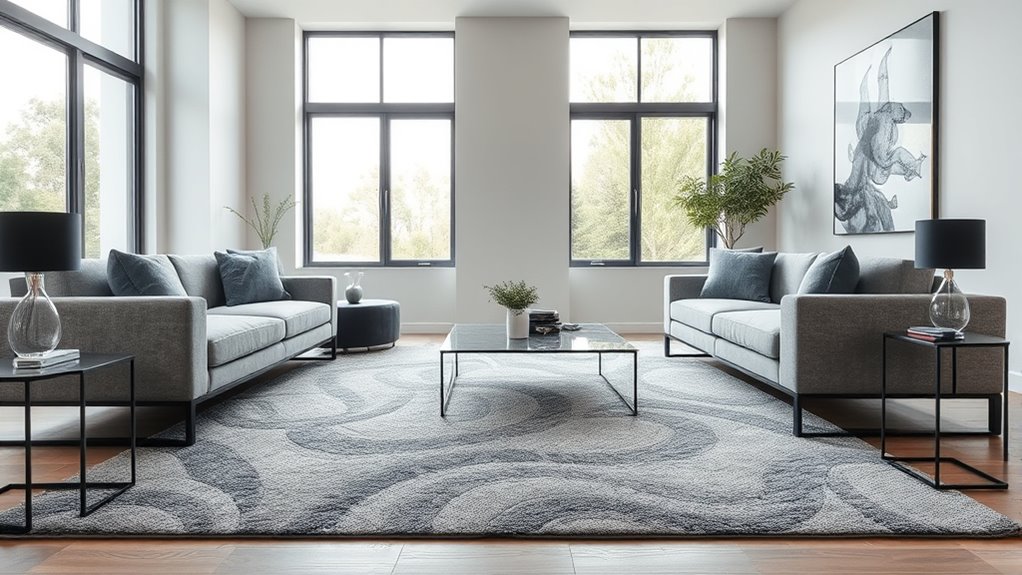
Before choosing a rug pattern, it’s essential to understand the style and mood you want to create in your space. Think about the overall atmosphere you aim for—whether it’s calm and relaxing, vibrant and energetic, or sophisticated and minimalist. Your furniture style influences this, so consider whether your pieces are sleek and modern or cozy and eclectic. Colors and textures also play a role; soft, muted tones set a tranquil tone, while bold hues energize a room. Clarifying your desired vibe helps you select patterns that reinforce the ambiance. For example, geometric designs add a contemporary edge, while organic motifs bring warmth. Additionally, incorporating anime-inspired decor can introduce a playful and unique element to your interior design. Defining your space’s mood guarantees your rug complements your furniture and enhances your overall interior aesthetic.
Selecting Rug Patterns That Complement Furniture Shapes
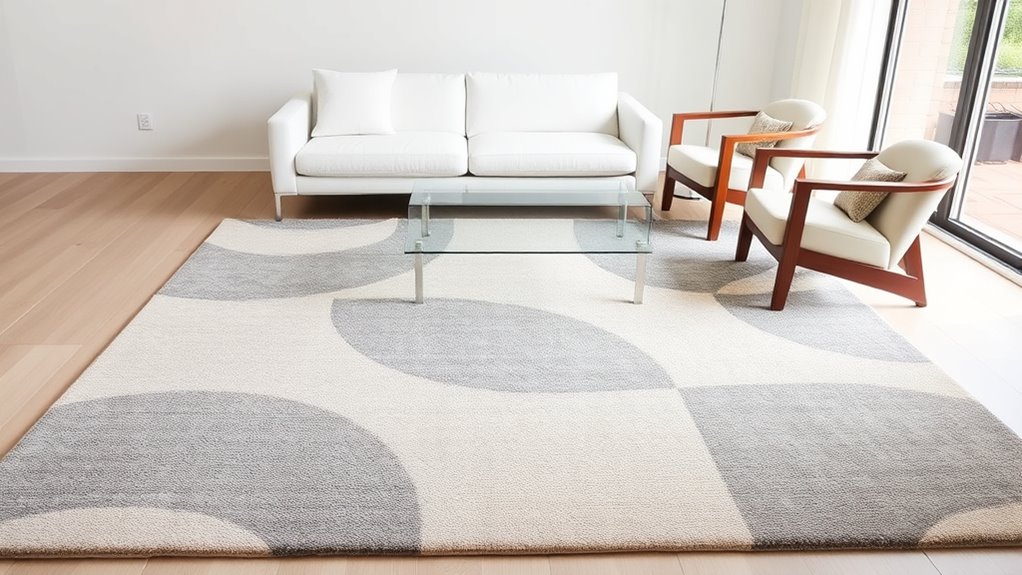
Choosing the right rug pattern involves considering how it interacts with your furniture’s shapes. If your furniture features clean, geometric lines, opt for rugs with bold, geometric patterns or simple designs that echo those shapes. For curved furniture, like rounded sofas or chairs, select rugs with softer, flowing patterns such as gentle waves or organic motifs. Solid colors can also work well with unique furniture shapes, providing a neutral backdrop that highlights the furniture’s form. Conversely, busy patterns may overwhelm delicate or minimalist furniture, so aim for subtle designs that enhance rather than compete. Additionally, exfoliation benefits from glycolic acid products can help create a fresh, clean space that complements your interior design. Ultimately, your goal is to create harmony between the rug’s pattern and furniture shapes, ensuring they complement each other and contribute to a cohesive space.
Balancing Bold Patterns With Minimalist Furniture

When incorporating bold patterns into a space with minimalist furniture, striking a careful balance is essential to prevent visual overload. You want the rug to make a statement without overwhelming the room’s simplicity. To achieve this, choose patterns with clean lines and limited colors, pairing them with neutral, understated furniture. Use the table below to visualize how bold and minimal elements can harmonize:
| Bold Pattern Elements | Minimalist Furniture Features |
|---|---|
| Large geometric shapes | Sleek, simple silhouettes |
| Vibrant color contrast | Muted, monochrome palette |
| Dynamic movement | Straight, unembellished forms |
| Intricate details | Clean, smooth surfaces |
Balancing these elements creates a visually engaging yet calming environment. Careful balancing ensures that bold pattern elements complement minimalist furniture without competing for attention.
Incorporating Texture and Material for Cohesive Design
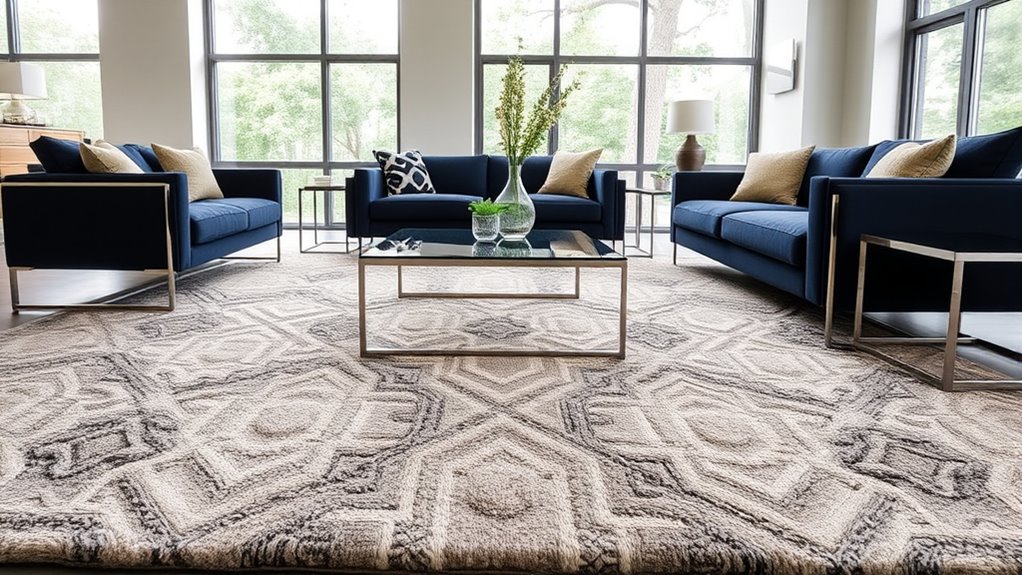
Incorporating texture and material into your space enhances cohesion by adding depth and tactile interest that unify your design elements. Choose rugs with diverse textures—think plush, sisal, or shag—to complement your furniture’s surfaces. For example, pairing a sleek leather sofa with a textured wool or jute rug creates visual contrast while maintaining harmony. Layer different materials, such as mixing soft textiles with rougher woven fibers, to add richness. Be mindful of the overall feel you want: smooth and sleek for modern spaces, or layered and tactile for cozy environments. Incorporating natural materials like linen or cotton can further enhance the authentic farmhouse feel. By thoughtfully selecting textures and materials, you can create a balanced, inviting atmosphere that ties your furniture and decor together seamlessly. This approach ensures your space feels cohesive, intentional, and visually engaging.
Using Color Coordination to Tie Elements Together

Color coordination acts as the finishing touch that unites your rug patterns with contemporary furniture lines. To achieve harmony, start by selecting a color palette that complements your furniture’s key hues. Use shades from your upholstery or accent pieces as a guide, ensuring your rug echoes these tones or introduces subtle contrasts. Incorporate neutral colors like beige, gray, or taupe to create a balanced backdrop, allowing patterned rugs to stand out without overwhelming the space. Consider the mood you want to set; cool tones evoke calmness, while warm hues add energy. Keep your color scheme consistent across elements to create a cohesive look. By thoughtfully coordinating colors, you tie all design elements together, making your space feel intentional and visually appealing.
Practical Tips for Mixing and Matching Patterns Effectively
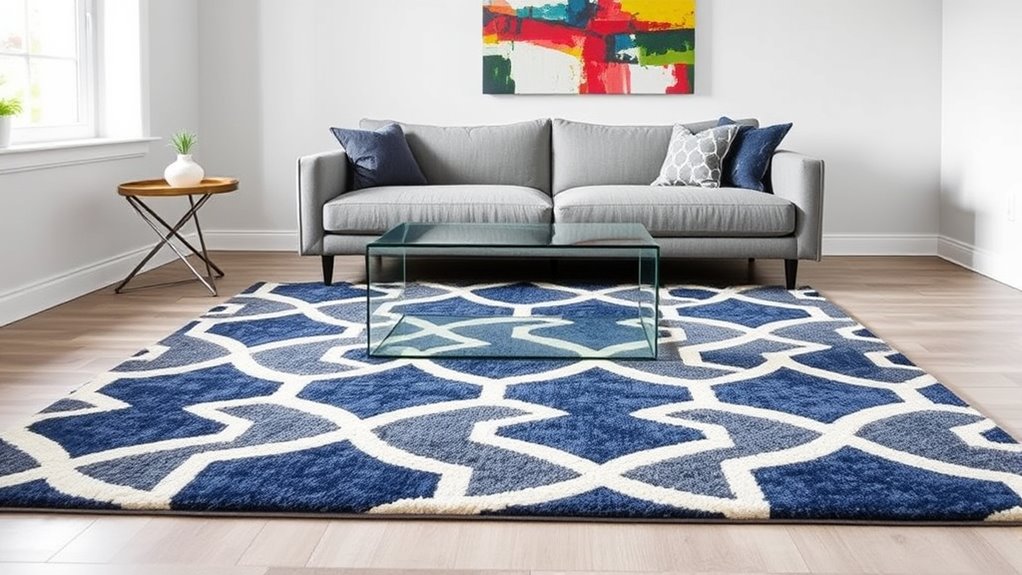
To successfully mix and match patterns in your space, start by balancing bold and subtle designs to prevent visual chaos. Use a dominant pattern as your anchor and introduce smaller, quieter patterns to complement it. Vary the scale of patterns—pair large, bold prints with tiny, intricate ones—to create visual interest without overwhelming the room. Stick to a cohesive color palette to tie different patterns together seamlessly. Don’t be afraid to mix textures; combining smooth and textured fabrics adds depth. Keep the overall look harmonious by repeating colors or patterns in different elements, such as cushions, curtains, or accessories. Additionally, choosing patterned textiles that are vetted ensures quality and longevity. Remember, the key is moderation—highlight one or two statement patterns and support them with subtle accents for a polished, balanced look.
Frequently Asked Questions
How Do I Choose a Rug Pattern for a Small Space?
When choosing a rug pattern for a small space, you want to create a sense of balance and openness. Opt for lighter colors and subtle patterns that won’t overwhelm the area. Geometric or simple designs work well, making the space feel larger. Avoid busy or dark patterns, as they can make the room seem cramped. You’re aiming for a rug that complements your furniture and enhances the room’s overall vibe.
What Patterns Work Best With Vintage or Antique Furniture?
Your question is a treasure chest of style possibilities. When pairing patterns with vintage or antique furniture, you want to strike a perfect balance. Opt for rugs with intricate patterns, floral designs, or subtle geometrics that echo the furniture’s historical charm. Avoid anything too modern or bold, which could overpower the room’s character. Instead, choose timeless patterns that enhance and highlight the antique beauty, creating an elegant, cohesive space that feels both fresh and rooted in history.
Can Mixing Multiple Rug Patterns Create a Cohesive Look?
Mixing multiple rug patterns can create a dynamic and interesting space, but it requires careful balance. You should choose patterns that share a common color palette or theme to keep the look cohesive. Avoid overwhelming the room by varying pattern scales—combine larger, bold designs with smaller, subtle ones. Trust your eye, and don’t be afraid to experiment; with thoughtful pairing, your space can feel lively and harmonious.
How Do I Maintain Rug Patterns Over Time?
To maintain your rug patterns over time, you should regularly vacuum to prevent dirt buildup and rotate the rugs periodically to avoid uneven wear. Address spills immediately with gentle cleaning, and avoid dragging furniture across the surface. Use rug pads to prevent slipping and preserve the pattern’s integrity. Keep your rugs out of direct sunlight to prevent fading, and schedule professional cleanings annually for deep maintenance.
Which Rug Patterns Are Most Suitable for High-Traffic Areas?
Imagine a busy hallway where footsteps dance across a rug. You want patterns that hide dirt and wear, so opt for geometric or abstract designs with bold, busy prints. These patterns don’t show stains easily and add visual interest amid chaos. Choose durable, tightly woven rugs made from stain-resistant fibers, ensuring your high-traffic areas stay stylish and fresh despite daily use.
Conclusion
When you match rug patterns to your furniture, you create a cohesive, inviting space. Did you know that 85% of interior designers say that well-coordinated patterns markedly boost a room’s appeal? So, take your time to choose patterns that complement your furniture’s shapes and textures. With thoughtful coordination, your living area will feel both stylish and harmonious, making every moment spent there more enjoyable.

